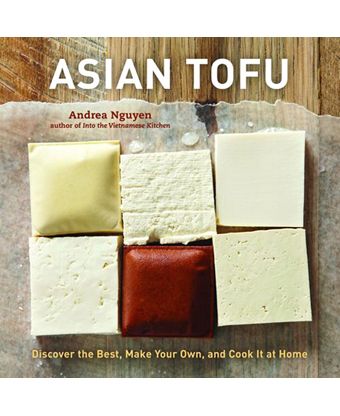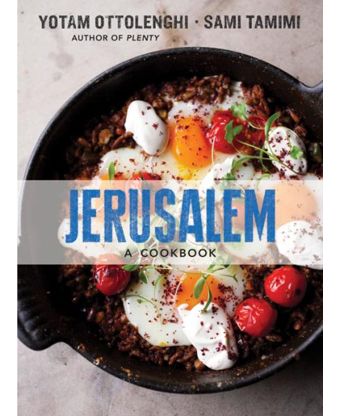While it may not be fair or wise to judge books by their covers, those of Asian Tofu and Jerusalem: A Cookbook give some blunt clues about what’s inside. Asian Tofu is a study in subtlety and minimalism — six squares of bean curd, representing a range of neutral tones, are laid out against an austere-looking slab of weathered wood. The title by itself has an academic ring to it and if it weren’t for the gimmicky tagline at the bottom — “Discover the Best, Make Your Own, and Cook It at Home” — you might mistake this cookbook for a textbook on the history and cultural significance of the food. Jerusalem, on the other hand, pops with the saffron yellow of egg yolks and the fiery red of cherry tomatoes. The effect is lush. The featured dish, served on a bed of ground lamb, looks homey, framed as it is by a cast-iron skillet. Something you could whip up and serve to a crowd of hungry brunch guests. So you might think that this book is going to encourage a more inspiring, improvisational approach.
But before we get into the merits and shortcomings of each book, one thing they have in common: both require you to seek out and spend a good chunk of change on ingredients that you are unlikely to find at your local market. Dried shrimp (Asian Tofu) and Sumac (Jerusalem) have yet to make it to the aisles of Whole Foods Market and even after visiting some specialty markets in my Manhattan neighborhood, I had to make do without either, which was frustrating, especially since neither author recommends any substitutions or discusses the impact that omitting obscure ingredients might have on the final product.
Within 24 hours of the books arriving at our home, I found Jerusalem had made its way to my wife’s bedside table. No surprise there. She likes to read cookbooks in bed and quickly cozied up with the sexier of the two. A few days later, we were experimenting with Swiss Chard Fritters, a total crowd pleaser that will no doubt be put into our regular rotation. Then, there was an attempt at Turkey & Zucchini Burgers with Green Onion & Cumin. While my wife pronounced them delicious, I found myself overwhelmed by the heat after one bite and not being a fan of cumin or cayenne pepper, two of the key components, I decided to steer clear.
After these first forays into Jerusalem, we decided to sit down to a proper meal of Roasted Chicken with Jerusalem Artichoke & Lemon, Chermoula Eggplant with Bulgur & Yogurt, and Roasted Butternut Squash & Red Onion with Tahini & Za’atar. In making the chermoula, “a powerful (read: crazy spicy) North African paste that is brushed over fish and vegetables,” you are instructed to mix together crushed garlic with several spices, and, get this, “two-thirds of the olive oil.” Normally, this instruction would seem like no big deal, except that the total amount of oil for the entire recipe was 2/3 cup, so now in the midst of measuring out a bunch of spices, I need to do middle school math in my head (“What’s 2/3 x 2/3?”) or eyeball it — both annoying options.
When it comes time to plate the various components of the dish, the instructions advise to “spoon the bulgur on top (of the eggplant), allowing some to fall from both sides. Spoon over some yogurt, sprinkle with cilantro, and finish with a drizzle of oil.” Confession of a neat freak: the whole messy assemblage left me feeling unsettled. The same could be said for the butternut squash recipe, which involves fewer ingredients but features no mention of what to do with the normally leathery squash skin—peel it off and discard? Scrub it clean and attempt to chew it? Details, details. The final dish was earthy thanks to the za’atar-inflected tahini sauce but otherwise not particularly exciting.
Another issue with Jerusalem is that you really need to read each recipe in its entirety before you begin to get an accurate sense of the time needed to prepare it. In the text for Roasted Chicken with Jerusalem Artichoke & Lemon, you learn in the last sentence of the second paragraph that the dish should be marinated in the fridge overnight. In the same sentence, “at least 2 hours” is deemed acceptable, but in this instance more time contributes more flavor, something that might have been better mentioned in the header.
Still, when the meal was over we agreed that the chicken and eggplant were winners. So, what Jerusalem’s recipes might lack in precise instructions, they usually make up for in interesting and intense flavors. It’s a fun book to flip through -- the pictures are true food porn and the text doesn’t waste time making its points. It’s the opposite of intimidating, but for cooks who crave more guidance, it may sometimes disappoint.
While the headnotes in Jerusalem tend to be chatty, those in Asian Tofu border on didactic. There is a four-paragraph lead-in to the recipe of Hakka-Style Stuffed Tofu! The recipe itself is laid in 7 steps, each comprised of a couple paragraphs highlighting the exact time, often down to the second, needed to complete certain tasks. While wading through all the text may seem arduous, the author anticipates any question or hesitation the cook might have. And the resulting little pork-filled pockets in savory-sweet broth go fast. My wife and I nailed 3/4 of them before we even sat down to dinner.
Next up was a dish called Simmered Greens with Fried Tofu, a riff on the creamed spinach dish that is a standby on most Indian restaurant menus. While soy might seem like a questionable substitute for fried cheese and the greens mixture does not call for any cream, the dish still ended up having a surprisingly rich consistency and great flavor. And just in case you entertain any doubts about how long to cook the greens, the recipe suggests “5 to 7 minutes, until the greens have wilted and just cooked through.” In need of additional verification? The author notes, “They will turn bright green and collapse to one-fourth to one-third of their original volume.”
If I had more time on my hands, I would have liked to follow the Homemade Tofu Tutorial that the book opens with, but in the end, I gave in to my relentless craving for noodles and made the Pad Thai with store-bought baked, pressed tofu. Making this dish at home is tricky as it requires a stove that produces a lot of heat and mine just isn’t up to the task. The recipe advises divvying up the ingredients into two batches so as not to crowd the pan, which is a smart tip if you are looking to maximize heat. In the end, the dish rivaled some of the best pad thai I’ve eaten in restaurants. The only shortcoming was the final chewy consistency of the noodles, which I soaked as instructed. I would have appreciated a note about how to assess the noodles’ readiness and was a bit surprised that the normally-thorough author gave no indication here.
So, after all this cooking and critiquing, how to pick the winner? My criteria in the end are simple. I’m a stickler for clarity, so whether I’m writing a recipe or attempting to follow one, I expect the communication to be full of specific and relevant details laid out in an easy-to-comprehend manner. It drives me crazy when cookbook writers assume too much. Even though I have more than 25 years of experience working in professional kitchens, I don’t want anyone taking for granted that I know how to execute their recipes from just a list of ingredients and a few general pointers about how to combine them. Jerusalem did just that on a number of occasions while Asian Tofu left no stone unturned when it came to detailing exactly what the home cook should be doing almost every step of the way.
The truth is I wanted to like Jerusalem more than I did -- its recipes are for the most part healthful and center on vegetables from every season whereas Asian Tofu calls for lots of sugar and salt-laden condiments to liven up its soy-centric dishes. But ultimately, the choice wasn’t that hard. When telling anyone how to make something, clarity and specificity should trump everything else. And so, Asian Tofu, you take home the gold.



85 Comments
I recently had a dinner party and made everything from Jerusalem. This was all new to me (Middle Eastern cooking), and everyone loved EVERYTHING. Everything I've made has come out amazing, however, I did have to do my own tweeks here and there. It's my new favorite cookbook, second to Sunday Suppers at Lucques. Thanks!
In any case, both are great cookbooks -- why choose? Get both and cook from them!
And there must be more than a couple of spice shops on your island. Sumac was too hard to find?